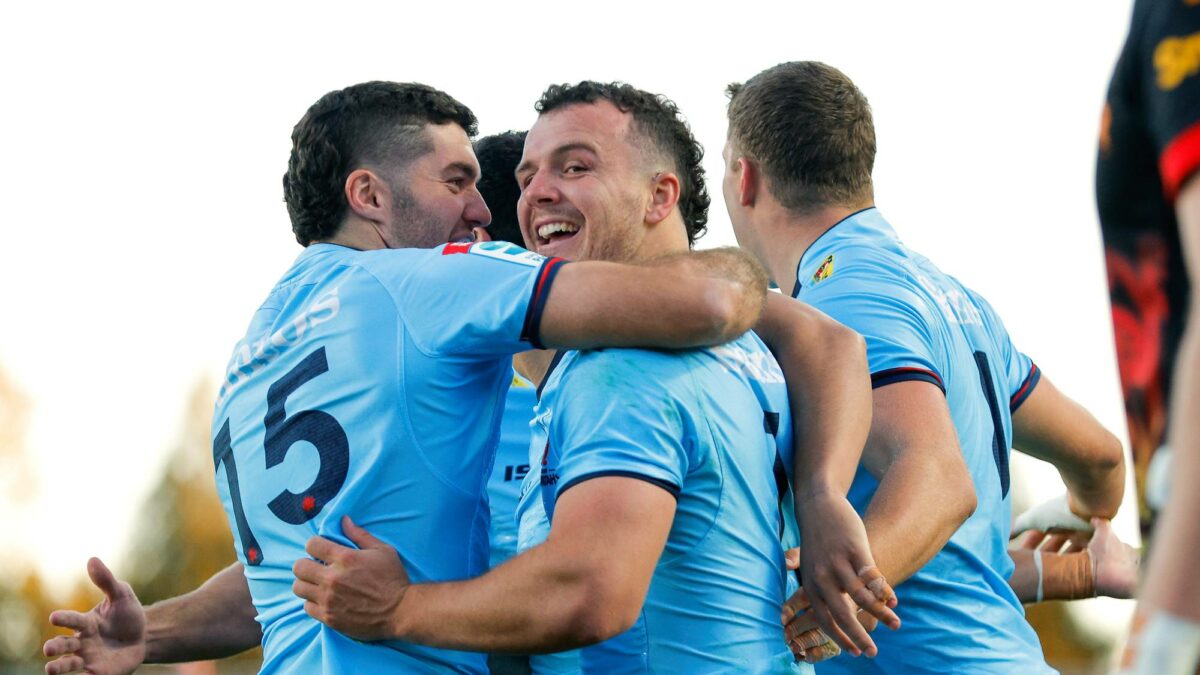After dropping five of their first six games, the Waratahs found their winning habit in Round 8 against the Western Force. Since then, they have been on a roll.
However, it was one outing prior to the Force game when things changed for them, at least from a tactical standpoint. Against the Brumbies, the Tahs transitioned from being a possession-oriented side to a kick-happy one.
NSW won the kick count 24 to 17 that night in Canberra – just the second time, to that point, they had kicked more times than their opposition.
This kick-happy approach then became a trend. The Waratahs have since then outkicked their opponents In all six subsequent games. In doing so, their number of kicks per game, on average, has risen from 19 to 25. Consequently, they have yielded the majority of possession to their opposition in all but one of these games.
This is not an accident. The strategy is clear from the Tahs – play for territory and rely more on their defence.
Here are some stats to show the comparison between the two different approaches:
Stat Possession-oriented (R1-5) c
Kicks in Play (avg) 19 25
Won majority of possession 3/5 1/7
Tackles (avg) 120 157
Rucks built (avg) 78 68
| Possession-oriented (R1-5) | Possession-oriented (R1-5) | |
| Kicks in Play (avg) | 19 | 25 |
| Won majority of possession | 3/5 | 1/7 |
| Tackles (avg) | 120 | 157 |
| Rucks built (avg) | 78 | 68 |
As you can see, the increased kicking has translated into more tackling and, correspondingly, less rucks built in attack.
Of course, there is fluidity within these two categories. The Tahs still kicked a fair amount during their possession-oriented games, while in this kick-happy period they are still attacking when opportunities arise.
Speaking of which, their attack looked as good as it has all season last weekend versus the Drua. Mark Nawaqanitawase, Max Jorgenson and Izaia Perese all had good involvements ball-in-hand, and the maul is increasingly becoming a weapon for NSW.
But nearly all of this is happening at their opponent’s end of the field. If they are in possession a long way from paydirt, then invariably it is a Jake Gordon box or a Ben Donaldson long kick to send the ball downtown.
During their possession-oriented phase, too many times their attack was stymied by opposition pilfers or penalty turnovers in their own half. The loss of Angus Bell very early in the year, as well as wrecking ball Langi Gleeson for a month, were big reasons why their attack was clunky. It is no wonder they have elected to kick more.
It is not just the quantity of kicks that has trended upwards. The quality has also improved with exits from inside their 22-metre line being noticeably better lately. Two timely 50-22 kicks from Michael Hooper and Joey Walton have also helped.
The Waratahs’ defence has responded favourably too, as it must with the ball more frequently in their opponent’s hands. In their past two games they have recorded a season-high 90 percent tackle-success rate.
Looking ahead, It’s hard to see NSW foregoing a tactic that’s led to five wins in seven games. But things are about to get tougher. They play the Crusaders this weekend who can be lethal on kick returns. The Tahs will face a similar threat in the quarter finals against another top Kiwi side or the Brumbies.
Ben Donaldson of the Waratahs (Photo by Kelly Defina/Getty Images)
That means that their defence needs to be as good as it has been recently, if not better. Also, Gordon’s up-and-under kicks will have to be pin-point accurate, while Donaldson’s downfield nudges must find the corners. If not, the Tahs will get burned on the counterattack.
It’s interesting that other Australian sides have recently had some success using similar tactics. In their shock win over the Chiefs in Round 11, the Reds kicked 36 times, made 220 tackles while surrendering 57 percent of possession.
This style of rugby may not be to everybody’s taste. Many prefer an approach of all-out attack with minimal kicking.
But you won’t hear any complaints coming from Wallabies’ coach, Eddie Jones. He has stated how important it is for Aussie teams to knock over their Kiwi adversaries and won’t mind how they do it.
Having coached abroad for 16 years, Jones now appreciates the different tactics that teams use to win matches. In his 2020 autobiography ‘My Life and Rugby’ he reflected on his time spent as a consultant with the Springboks. It was then that he observed how differently the South Africans played rugby.
Prior to then, Jones had espoused the typically Australian approach of maintaining possession of the ball and building pressure on their opponents through phase play.
The Boks, he noticed, often took the inverse approach. Instead of keeping the ball, they regularly kicked it away and used their defence to build pressure. Sound familiar?
It will be intriguing to see which approach the worldly Wallabies head honcho takes with the national side later this year. Sam Larner, in his excellent article this week, argued that Jones might adopt a possession approach based on who he is likely to pick in the squad. We’ll wait and see on that.
As for the Tahs, their kick-happy approach has triggered a successful stretch that has vaulted them from second bottom on the table to sixth. How well it continues to work will determine their fate at the season’s pointy end.
